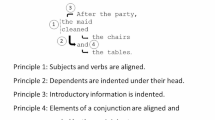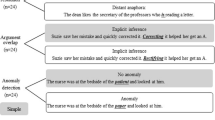Abstract
This study aimed to validate the Simple View of Reading (SVR) in L2 English readers with alphabetic and morphosyllabic L1 writing system backgrounds. Forty-five L2 English learners enrolled in American university bridge programs completed a set of tasks that measured real word decoding efficiency, pseudoword decoding efficiency, linguistic (listening) comprehension, passage reading comprehension, and word meaning inferencing. There were two major findings: (1) only pseudoword decoding efficiency predicted passage reading comprehension in learners with a morphosyllabic L1, whereas both pseudoword decoding efficiency and linguistic comprehension were significant predictors in learners with an alphabetic L1; (2) pseudoword decoding efficiency was a significant predictor of word meaning inferencing in learners with a morphosyllabic L1, and moderated the effect of real word decoding efficiency on word meaning inference in learners with an alphabetic L1. The findings indicate the complex relationships among word decoding, linguistic comprehension, and passage reading comprehension in adult L2 English learners.


Similar content being viewed by others
Notes
Arabic has been classified as an abjad or alphabetic language in previous research. We treat it as an alphabetic language in this study.
The statistical assumptions were checked to ensure the robustness of MANOVA test. The Shapiro–Wilk test suggested that every dependent variable was normally distributed (p > 0.05). Levene’s Test of Equality of Error Variances showed the observed error variances of the dependent variables were generally equal across groups, except that some violation was found for listening comprehension (p = 0.022) and real word decoding (p = 0.018). The Pearson correlations indicated that the dependent variables were correlated moderately with each other (see Table 2). Box’s Test of Equality of Covariance Matrices indicated that the covariance matrices between the groups were equal (p = 0.256). As a result, Pillais’ Trace was used for data interpretation.
References
Adlof, S. M., Catts, H. W., & Little, T. D. (2006). Should the simple view of reading include a fluency component? Reading and Writing, 19(9), 933–958. https://doi.org/10.1007/s11145-006-9024-z
Babayiğit, S. (2015). The relations between word reading, oral language, and reading comprehension in children who speak English as a first (L1) and second language (L2): A multigroup structural analysis. Reading and Writing, 28(4), 527–544. https://doi.org/10.1007/s11145-014-9536-x
Bonifacci, P., & Tobia, V. (2017). The simple view of reading in bilingual language-minority children acquiring a highly transparent second language. Scientific Studies of Reading, 21(2), 109–119. https://doi.org/10.1080/10888438.2016.1261869
Brown, T. L., & Haynes, M. (1985). Literacy background and reading development in a second language. New Directions for Child and Adolescent Development, 1985(27), 19–34. https://doi.org/10.1002/cd.23219852704
Cho, E., Capin, P., Roberts, G., Roberts, G. J., & Vaughn, S. (2019). Examining sources and mechanisms of reading comprehension difficulties: Comparing English learners and non-English learners within the simple view of reading. Journal of Educational Psychology, 111(6), 982–1000. https://doi.org/10.1037/edu0000332
Clarke, M. A. (1980). The short circuit hypothesis of ESL reading: Or when language competence interferes with reading performance. The Modern Language Journal, 64(2), 203–209. https://doi.org/10.1111/j.1540-4781.1980.tb05186.x
Cohen, J. (1969). Statistical power analysis for the behavioral sciences. Academic Press.
Cziko, G. A. (1980). Language competence and reading strategies: A comparison of first- and second-language oral reading errors. Language Learning, 30(1), 101–114. https://doi.org/10.1111/j.1467-1770.1980.tb00153.x
Droop, M., & Verhoeven, L. (2003). Language proficiency and reading ability in first- and second-language learners. Reading Research Quarterly, 38(1), 78–103. https://doi.org/10.1598/RRQ.38.1.4
Erbeli, F., & Joshi, R. M. (2022). Simple view of reading among Slovenian English foreign language learners: A latent interaction modeling approach. Learning and Individual Differences, 93, 101958. https://doi.org/10.1016/j.lindif.2020.101958
Farnia, F., & Geva, E. (2013). Growth and predictors of change in English language learners’ reading comprehension. Journal of Research in Reading, 36(4), 389–421. https://doi.org/10.1111/jrir.12003
Field, A. (2009). Discovering statistics using SPSS (3rd ed.). SAGE Publications Ltd.
Florit, E., & Cain, K. (2011). The simple view of reading: Is it valid for different types of alphabetic orthographies? Educational Psychology Review, 23(4), 553–576. https://doi.org/10.1007/s10648-011-9175-6
Ghaedsharafi, A., & Yamini, M. (2011). Evaluation of the simple view of reading in an EFL context: An additive or product model? International Journal of English Linguistics. https://doi.org/10.5539/ijel.v1n2p196
Gough, P. B., & Tunmer, W. E. (1986). Decoding, reading, and reading disability. Remedial and Special Education, 7(1), 6–10. https://doi.org/10.1177/074193258600700104
Hamada, M., & Koda, K. (2010). The role of phonological decoding in second language word-meaning inference. Applied Linguistics, 31(4), 513–531. https://doi.org/10.1093/applin/amp061
Hayes, A. F. (2018). Partial, conditional, and moderated moderated mediation: Quantification, inference, and interpretation. Communication Monographs. https://doi.org/10.1080/03637751.2017.1352100
Hoover, W. A., & Gough, P. B. (1990). The simple view of reading. Reading and Writing, 2(2), 127–160. https://doi.org/10.1007/BF00401799
Huo, M. R., Koh, P., Cheng, Y., Marinova-Todd, S. H., & Chen, X. (2021). The simple view of reading in French second language learners. Learning and Individual Differences, 92, 102082. https://doi.org/10.1016/j.lindif.2021.102082
Jeon, E. H., & Yamashita, J. (2014). L2 reading comprehension and its correlates: A meta-analysis. Language Learning, 64(1), 160–212. https://doi.org/10.1111/lang.12034
Jiang, X. (2016). The role of oral reading fluency in ESL reading comprehension among learners of different first language backgrounds. Reading Matrix: An International Online Journal, 16(2), 227–242.
Joshi, R. M. (2018). Simple View of Reading (SVR) in different orthographies: Seeing the forest with the trees. In T. Lachmann & T. Weis (Eds.), Reading and dyslexia: Perspectives from Cognitive neurosciences, linguistics, psychology and education) (pp. 71–80). Springer. https://doi.org/10.1007/978-3-319-90805-2_4
Kang, Y. (2020). Relative contribution of reading fluency and vocabulary knowledge in predicting Korean EFL learners’ reading comprehension. The Journal of Asia TEFL, 17(3), 778–790. https://doi.org/10.18823/asiatefl.2020.17.3.2.778
Koda, K. (2005). Insights into second language reading: A cross-linguistic approach. Cambridge University Press. https://doi.org/10.1017/CBO9781139524841
Lervåg, A., & Aukrust, V. G. (2010a). Vocabulary knowledge is a critical determinant of the difference in reading comprehension growth between first and second language learners. Journal of Child Psychology and Psychiatry, and Allied Disciplines, 51(5), 612–620. https://doi.org/10.1111/j.1469-7610.2009.02185.x
Lervåg, A., & Aukrust, V. G. (2010b). Vocabulary knowledge is a critical determinant of the difference in reading comprehension growth between first and second language learners. Journal of Child Psychology and Psychiatry, 51(5), 612–620. https://doi.org/10.1111/j.1469-7610.2009.02185.x
Lin, C. M. (2003).Determining meaning of unfamiliar English words: The case of Taiwanese EFL students (Doctoral dissertation). Texas A&M University-Kingsville.
Mancilla-Martinez, J., Kieffer, M. J., Biancarosa, G., Christodoulou, J. A., & Snow, C. E. (2011). Investigating English reading comprehension growth in adolescent language minority learners: Some insights from the simple view. Reading and Writing, 24(3), 339–354. https://doi.org/10.1007/s11145-009-9215-5
Melby-Lervåg, M., & Lervåg, A. (2011). Cross-linguistic transfer of oral language, decoding, phonological awareness and reading comprehension: A meta-analysis of the correlational evidence. Journal of Research in Reading, 34(1), 114–135. https://doi.org/10.1111/j.1467-9817.2010.01477.x
Metsala, J. L., Sparks, E., David, M., Conrad, N., & Deacon, S. H. (2021). What is the best way to characterise the contributions of oral language to reading comprehension: Listening comprehension or individual oral language skills? Journal of Research in Reading, 44(3), 675–694. https://doi.org/10.1111/1467-9817.12362
Miller, R. (2013). Cross-linguistic influences of L2 semantic gap filling and its component sub-skills (Doctoral dissertation). Carnegie Mellon University.
Nakamoto, J., Lindsey, K. A., & Manis, F. R. (2008). A cross-linguistic investigation of English language learners’ reading comprehension in English and Spanish. Scientific Studies of Reading, 12(4), 351–371. https://doi.org/10.1080/10888430802378526
Pasquarella, A., Gottardo, A., & Grant, A. (2012). Comparing factors related to reading comprehension in adolescents who speak English as a first (L1) or second (L2) language. Scientific Studies of Reading, 16(6), 475–503. https://doi.org/10.1080/10888438.2011.593066
Plonsky, L., & Derrick, D. J. (2016). A meta-analysis of reliability coefficients in second language research. The Modern Language Journal, 100(2), 538–553. https://doi.org/10.1111/modl.12335
Plonsky, L., & Ghanbar, H. (2018). Multiple regression in L2 research: A methodological synthesis and guide to interpreting R2 values. The Modern Language Journal, 102(4), 713–731. https://doi.org/10.1111/modl.12509
Prior, A., Goldina, A., Shany, M., Geva, E., & Katzir, T. (2014). Lexical inference in L2: Predictive roles of vocabulary knowledge and reading skill beyond reading comprehension. Reading and Writing, 27(8), 1467–1484. https://doi.org/10.1007/s11145-014-9501-8
Sabatini, J., Bruce, K., & Steinberg, J. (2015). SARA reading components tests, RISE form: Technical adequacy and test design. ETS Research Report Series. https://doi.org/10.1002/j.2333-8504.2013.tb02315.x
Schmidtke, D., & Moro, A. L. (2020). Determinants of word-reading development in English learner university students: A longitudinal eye movement study. Reading Research Quarterly, 56(4), 819–854. https://doi.org/10.1002/rrq.362
Share, D. L. (1995). Phonological recoding and self-teaching: Sine qua non of reading acquisition. Cognition, 55(2), 151–218. https://doi.org/10.1016/0010-0277(94)00645-2
Sparks, R. (1995). Examining the linguistic coding differences hypothesis to explain individual differences in foreign language learning. Annals of Dyslexia, 45(1), 187–214. https://doi.org/10.1007/BF02648218
Sparks, R. (2021). Identification and characteristics of strong, average, and weak foreign language readers: The simple view of reading model. The Modern Language Journal, 105(2), 507–525.
Sparks, R., & Ganschow, L. (1993). The impact of native language learning problems on foreign language learning: Case study illustrations of the linguistic coding deficit hypothesis. The Modern Language Journal, 77(1), 58. https://doi.org/10.2307/329559
Sparks, R., & Luebbers, J. (2018). How many U.S. high school students have a foreign language reading “disability”? Reading without meaning and the simple view. Journal of Learning Disabilities, 51(2), 194–208. https://doi.org/10.1177/0022219417704168
Sparks, R., & Patton, J. (2016). Examining the simple view of reading model for United States high school Spanish students. Hispania, 99(1), 17–33.
Sparks, R., Patton, J., Ganschow, L., & Humbach, N. (2012). Do L1 reading achievement and L1 print exposure contribute to the prediction of L2 proficiency? Language Learning, 62(2), 473–505. https://doi.org/10.1111/j.1467-9922.2012.00694.x
Torgesen, J. K., Rashotte, C. A., & Wagner, R. K. (1999). TOWRE: Test of word reading efficiency. Pro-Ed.
Trapman, M., van Gelderen, A., van Schooten, E., & Hulstijn, J. (2017). Reading comprehension level and development in native and language minority adolescent low achievers: Roles of linguistic and metacognitive knowledge and fluency. Reading & Writing Quarterly, 33(3), 239–257. https://doi.org/10.1080/10573569.2016.1183541
Uchikoshi, Y. (2013). Predictors of English reading comprehension: Cantonese-speaking English language learners in the U.S. Reading and Writing, 26(6), 913–939. https://doi.org/10.1007/s11145-012-9398-z
Verhoeven, L., & van Leeuwe, J. (2012). The simple view of second language reading throughout the primary grades. Reading and Writing, 25(8), 1805–1818. https://doi.org/10.1007/s11145-011-9346-3
Verhoeven, L., Voeten, M., & Vermeer, A. (2019). Beyond the simple view of early first and second language reading: The impact of lexical quality. Journal of Neurolinguistics, 50, 28–36. https://doi.org/10.1016/j.jneuroling.2018.03.002
Wang, Z., Sabatini, J., O’Reilly, T., & Weeks, J. (2019). Decoding and reading comprehension: A test of the decoding threshold hypothesis. Journal of Educational Psychology, 111(3), 387–401. https://doi.org/10.1037/edu0000302
Xue, J. (2021). The developmental trajectory of biliteracy for Chinese-English adult EFL learners: A longitudinal study. Reading and Writing, 34(4), 1089–1114. https://doi.org/10.1007/s11145-020-10105-6
Zhang, D., & Ke, S. (2020). The simple view of reading made complex by morphological decoding fluency in bilingual fourth-grade readers of English. Reading Research Quarterly, 55(2), 311–329. https://doi.org/10.1002/rrq.287
Ziegler, J. C., & Goswami, U. (2005). Reading acquisition, developmental dyslexia, and skilled reading across languages: A psycholinguistic grain size theory. Psychological Bulletin, 131(1), 3–29. https://doi.org/10.1037/0033-2909.131.1.3
Funding
This research is funded by 2019 Language Learning Early Career Research Grant awarded to Dr. Sihui (Echo) Ke.
Author information
Authors and Affiliations
Corresponding author
Ethics declarations
Conflict of interest
None.
Ethical Approval
The study has been approved by the IRB office of the University of Kentucky and has been performed in accordance with the ethical standards as laid down in the 1964 Declaration of Helsinki and its later amendments or comparable ethical standards.
Additional information
Publisher's Note
Springer Nature remains neutral with regard to jurisdictional claims in published maps and institutional affiliations.
Appendices
Appendix A
See Table 9.
Appendix B
See Table 10.
Appendix C
See Table 11.
Appendix D
See Table 12.
Appendix E
See Table 13.
Appendix F
See Table 14.
Rights and permissions
Springer Nature or its licensor (e.g. a society or other partner) holds exclusive rights to this article under a publishing agreement with the author(s) or other rightsholder(s); author self-archiving of the accepted manuscript version of this article is solely governed by the terms of such publishing agreement and applicable law.
About this article
Cite this article
Li, X., Miller, R.T., Zhang, J. et al. Profiling Adult L2 Readers in English Bridge Programs: A Not-So-Simple View of L1 Effect. J Psycholinguist Res 52, 1471–1496 (2023). https://doi.org/10.1007/s10936-023-09955-2
Accepted:
Published:
Issue Date:
DOI: https://doi.org/10.1007/s10936-023-09955-2




